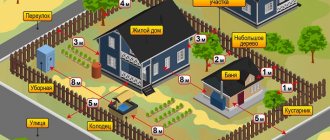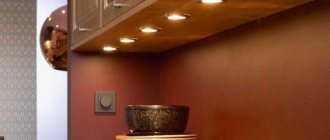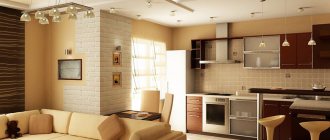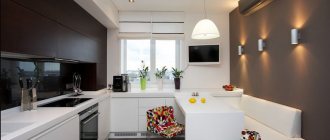Rules for organizing lighting
General recommendations:
- The hallway should be equipped with lamps with maximum power. This way you can install only one light source and thereby save space in a small room.
- In order to have a sufficient amount of light in the corridor, preference is given to lamps with a white or yellow glow. Energy-saving devices with matte white light that does not irritate or dazzle the eyes are also ideal.
- In a room with low ceilings, the use of massive chandeliers is not recommended. It is better to place wall sconces in the interior with a luminous flux directed upward. This will visually increase the height of the ceiling.
- It is appropriate to complement a hallway with a high ceiling with low-hanging pendant lamps. If the room has an elongated shape, install several lamps.
- To expand a narrow corridor, lighting should be directed to the upper part of the wall plane.
- The corridor space, characterized by a square configuration, is equipped with a large central lamp, which acts as the main accent.
- Lighting fixtures in combination with light wall decoration and mirror surfaces visually expand the room.
The photo shows a hallway design with wall lighting and spotlights on the ceiling.
Area in front of the garage
Outdoor lights should also be placed near the garage door and on the driveway. One or more lanterns will do the job perfectly: it all depends on the size of the access area.
Lamps with gas-discharge lamps on high supports have proven themselves to be excellent. They evenly illuminate the road surface and the surrounding area, do not require maintenance, and last for at least 6 years. It is convenient to control such lamps using a twilight relay: it will automatically turn on the lamps as soon as natural light becomes insufficiently bright.
Be sure to take into account the existing lighting of streets and neighboring areas. Your area may be illuminated by someone else's light source, and your lamp may disturb your neighbors. Think about how not to disturb the overall comfort.
Types of lighting
Options for lighting used.
Basics
Most often, the main light is a chandelier. In most cases, the device is placed slightly below the level of the ceiling plane.
Spotlights are suitable for suspended or suspended ceilings. Thanks to the glossy film with a reflective effect, you can achieve additional light in the corridor.
The photo shows the main lighting with rotating ceiling spots in the interior of the corridor.
You can create general lighting using ceiling or wall spots. A design with several rotating lamps mounted on one rod can illuminate the entire corridor.
Sconces are sometimes used as independent light. For example, in a small room, a couple of lighting fixtures located at a height of approximately 2 meters will be sufficient.
Auxiliary
Local light makes the interior more convenient and comfortable. Lighting in certain areas of the hallway or corridor helps to zone the space. Using floor lamps, wall lamps, LED or neon strips, you can organize the illumination of mirrors, paintings, decorative elements, hangers or wardrobes.
Auxiliary LED lighting also facilitates safe movement at night. To do this, spot lighting is installed in the corridor on the floor or at the bottom of the walls.
The photo shows a floor lamp as auxiliary lighting in the interior of the corridor.
Decorative
Thanks to decorative lighting, it is possible to achieve an artistic design of the room and emphasize the design of the corridor.
To organize light, LED strips are used, mounted in ceiling plinths; various neon signs, panels, retro lamps or candles are used.
Another way to decorate the hallway space in an original way is to decorate furniture, mirrors or doors with garlands. You can also use them to create a bright drawing or inscription on the wall.
Lighting of the utility yard and outbuildings
The diligent owners of the estate almost constantly have some kind of work going on. Most often, to prevent dirt and debris from spreading, the work site is organized within a fenced-off area, which is called a utility yard or utility yard. The utility yard can be permanent or temporary, but in any case it should be sufficiently well lit in the evening. Suitable luminaires for this purpose can be floodlights equipped with metal halide gas-discharge LHPs. Installed on the walls of buildings or on special supports, these spotlights are capable of providing illumination of 100-200 lux from a distance of several meters. In addition, they do not distort the natural colors of objects.
Metal halide floodlight
For example, for a permanent rectangular utility yard with an area of 100 m2, you can use 4 floodlights with a linear (soffit) metal halide LHP with a power of 70 W. Installed at a height of 3-4 m on the sides of the yard, the floodlights will provide illumination of at least 100 lux over its entire area. In addition, the floodlights have a degree of protection IP65, which guarantees their long-term operation as outdoor luminaires.
Lighting of the utility yard is required only for the duration of the work. Therefore, to turn it on and off, one- or two-pole switches should be provided, allowing you to control all the spotlights simultaneously or each of them separately.
As a more modern option, it is increasingly recommended to use outdoor LED lamps.
Outdoor LED lamps SDKU-L
Features of choosing the shape and size of the hallway
The corridor may have different configurations. There are long and narrow spaces, square, small rooms or a large spacious hall.
What lamps are best for a small hallway?
A non-bulky ceiling lamp with high power in combination with recessed lamps is suitable. If the ceiling covering does not provide for the installation of spotlights, the chandelier can be supplemented with a pair of wall fixtures in an identical design.
The photo shows a small hallway equipped with ceiling and wall lights.
Lighting in a small hallway in a Khrushchev-era apartment requires proper design. The room should not create unnecessary shadows or leave dark corners.
If a wardrobe is intended to be placed, it is supplemented with built-in lamps. Lamps on the ceiling should have a luminous flux oriented in one direction. The light emanating from wall fixtures is directed upward.
Lighting in a long corridor
To visually expand a narrow corridor space, preference is given to compact, but at the same time quite powerful ceiling lamps. The devices are placed in one line along the entire length of the hallway, a checkerboard order or chaotic placement is used. It is appropriate to complement the room with wall lamps, which, in combination with light finishes, will give the room even more volume. In a narrow corridor, daylight should be used.
The photo shows lighting with spots on the ceiling in a narrow corridor.
Bright central light and a small shadow in the corner parts of the corridor will help to adjust the space. This way the room will acquire more correct proportions and become more comfortable. You can also visually expand the hallway due to oblong lamps located across.
For lighting in the interior of a long corridor, it will be very convenient to install walk-through switches at the beginning and end of the room.
It is also possible to equip the light with a motion sensor. Then the lamps will turn on only when a person is in the hallway. Such a solution will contribute to significant savings in electrical energy.
What to choose for an L-shaped hallway?
Several types of lighting are used here and the space is divided into functional areas. The main light source is installed next to the front door, and local lighting is used for the area with a cabinet or mirror.
For such a hallway, built-in lamps located perpendicular to each other are ideal. If there is a two-level ceiling, each tier is equipped with devices of different diameters.
The photo shows the interior of an L-shaped corridor in an apartment with different types of lighting.
Automation on/off
Despite the fact that the presence of sensors requires additional costs and also complicates installation, it is convenient and economical. There are time relays that can turn the street lights of a house on and off at a given time. It makes sense to install such systems on security and functional lighting. You can also think about installing a relay for decorative lighting - also convenient.
Street lighting at home consists of several parts
In less-frequented places, where you only need to turn on the lights when you are there, you can install motion sensors. They can also be part of security lighting - if there is movement, spotlights that were not working before will turn on. The surprise will not be pleasant. Another thing is that the sensor can trigger on a dog or other animal that comes into its field of view. But the security functions will still be more effective.
Another opportunity to automate the street lighting of a private home is to install a photo relay. It reacts to a decrease in the amount of light, including the lamp power circuit. Also in automatic mode, the power turns off when the sun begins to rise.
Another video on the topic
Lamp location
In order to correctly arrange lighting fixtures, you need to visually determine the purpose and functions of each specific area in the hallway.
The area with the front door is the first. This segment is equipped with a switch and a sufficient amount of light, which provides a convenient search for clothes and shoes.
The second zone for organizing lighting in the hallway is a place near or above the mirror. It is appropriate to place light sources on the wall on the sides of the mirror sheet or decorate it with an LED strip, which will give the hallway decor elegance and originality. Mirrored cabinet doors are most often illuminated by ceiling lights.
The photo shows ceiling lighting in the hallway, located above the door and above the mirrored wardrobe.
The area with a closet, hanger or shelves is the third zone. Devices built into furniture are perfect for lighting it.
The fourth segment with an armchair or sofa is mainly present in the interior of a large hallway; in order to organize lighting and create a comfortable environment, a floor lamp can be installed near the upholstered furniture.
The photo shows an area with an armchair in the hallway, complemented by a floor lamp.
Are we lighting the facade or porch?
It is best to start arranging outdoor lighting from the house itself. In order to easily get into your home at night, you need light that allows you to see the front door, porch and area in front of the house.
In private houses, facade lighting is used. Options:
- flood lighting, it creates uniform illumination of the facade walls;
- accent lighting to highlight decorative elements of the facade and visually eliminate defects;
- contour lighting using LED tubes, which allows you to emphasize the contours of the house (this technique is often used for festive decoration);
- background lighting, when lamps are installed close to the ground and create a harmonious play of light and shadow.
If all the houses on your street can boast of original façade lighting, you can safely use this method. However, making your home the brightest object at night is hardly appropriate. Everything needs to be done in moderation. It is better to use the light of the original street lamp above the porch, or place beautiful lamps on the sides of the front door.
You can install recessed lights in a low fence or wall along the path that will illuminate it in the evening without being in your eyes.
Features of lighting with suspended ceilings
First of all, to illuminate a hallway with a suspended ceiling, you should choose sources with light bulbs with a power of up to 35 W. Devices that are too powerful can damage the ceiling covering due to high temperatures.
Overhead chandeliers with a shade that provides rapid cooling or LED lighting, which is an original decorative element and a means of zoning, are ideal.
The photo shows the design of a hallway with a suspended ceiling equipped with spotlights.
The most common type of lighting structures for stretched fabric are spotlights. The devices have a large number of placement schemes. For example, if there is a central light source, spot products are installed in each corner of the corridor, on the sides of the main ceiling chandelier, in a straight line or in a zigzag.
If two types of recessed spotlights are involved in the design of the hallway, they are alternated with each other or a checkerboard pattern is used.
Choosing lamps to illuminate the garden inside
Specialized stores for the site and garden stock a huge assortment of lamps in different price categories. Let's divide them into three large groups, which differ from each other in the type of lighting element installed in the device. Here are the most common varieties now:
- Sodium . Inside the lamp of such a lamp there is sodium in gaseous form. When an electric current passes through it, the lamp emits a soft and even light with a warm tint. This feature makes sodium lamps indispensable for decorative lighting of objects on the site. It is impossible not to note the long service life of such lamps, it is about 3 - 4 years.
- LED . These lamps have taken over the market in recent years and are considered the most high-tech. It is for this reason that the price tag for LED lamps is still high, although even at this cost the purchase will be profitable. An economical, surge-resistant LED lamp can last about 6 years. Also, on many models it is possible to adjust the power, and, therefore, adjust the illumination to individual needs.
- Halogen is the most common group of devices at the moment. The principle of their operation is similar to sodium lamps: there is a gaseous substance in the lamp bulb, the passage of current provokes a glow, which, by the way, is much brighter than that of standard incandescent lamps. Such lamps are a complete golden mean in this segment: they are quite cheap, do not break down for a long time, are quite economical and provide a lot of light.
We would like to separately mention autonomous lamps for the site. Although they are, in fact, representatives of the group of LED devices, they work according to a unique principle. At the top of such a lamp there is a solar battery, and while the sun is shining, the lamp charges the battery, which then powers the lighting element. Due to the fact that LED is used as a lamp, the charge lasts for a very long time. Consequently, such a lamp fully justifies its title of autonomous.
Let us demonstrate in the photo what designs there are for autonomous lamps for the site - from classic to avant-garde.
A separate advantage of such a device is its mobility. Conventional lamps need to be mounted, as well as wiring to them. Autonomous models, in most cases, just need to be stuck into the ground - this completes the installation process. Dismantling of devices occurs with the same simplicity, so you can easily, if necessary, remove all lighting fixtures from the local area for a while.
Nuances for a private home
Unlike an apartment, a corridor in the interior of a house may have a source of natural light in the form of a window. However, in any case, it is necessary to organize the necessary level of artificial lighting. To ensure a uniform light flow, ceiling spotlights are perfect.
The photo shows lighting with spotlights in the hallway of a wooden house.
It is important to take into account all the features of corridor lighting in the house, as incorrect placement of lighting fixtures will deprive the room of warmth and comfort. For example, in the interior of a wooden building, one should take into account the fact that wood has the ability to absorb light. Therefore, in addition to diffuse lighting, you will need to install additional lighting.
Planning lighting for the garden area
Before you begin installing the lighting system, you need to carefully plan everything, otherwise the lamps will not emphasize the dignity of the site, but will only disfigure it. The light source placement plan should contain the following points:
- Location of pillars.
- Wiring system.
- Connection type and features.
- Type of lamps and their quantity.
If you take into account all the nuances during planning, then installing the lighting system will not take much time and effort; you can handle it yourself. The main place where installation of lamps is necessary is the entrance to the site (gate) and the porch of a private house. The owner of the building at night must see everything that happens near the gate, so lamps installed there are usually equipped with motion sensors, which is very convenient and economical.
Often, LED floodlights are used to illuminate the area, which have good light output and low power consumption. Another undeniable advantage of LED lamps is their long service life.
If the site has a recreation area or gazebo, children's playground or barbecue, then it is imperative to illuminate the area around them and the garden paths leading to them. You can also equip the parking area with a lamp so that it can be seen at night, in addition, the lighting will simplify the parking process. Also, when designing a lighting system, it is important to figure out how to connect the lamps with an electric cable, and it will be laid through an underground tunnel or overhead line.
The second option is simpler and cheaper, but for this you need to buy a special drop that is resistant to wind loads, and you will also have to use a wire that can hold the cable suspended. As for the underground cable, it must be hidden in a metal sleeve, which increases costs. At the same time, a cable located underground can last several times longer, which justifies the costs.
Photo in the interior of the hallway
Modern lighting design has many functional capabilities that allow you to radically change the visual perception of the hallway interior and create the necessary atmosphere in the room.
Thanks to unusual and original lighting, you can achieve mysterious twilight in a room, give the corridor an unusual volume, or even create a real wall picture using lighting devices.
A little about the efficiency of outdoor lighting
The priority of using LED equipment in outdoor lighting is not accidental: such lighting devices are extremely economical in terms of energy consumption. For small households, in which the role of an external lighting system is played by one or two lanterns near the gate and front door, this is not very relevant. But for medium and large areas, when the street lighting system uses several dozen lamps, electricity consumption by the “street” alone can reach several kilowatts per day.
In addition, when using LED emitters, it is quite simple to arrange outdoor lighting for an area that does not have a power supply line at all. Manufacturers produce a large number of LED lamps, completely autonomous and powered by solar panels (panels). It is quite difficult to organize full-scale illumination of an area with them for many hours - however, with a small size of the illuminated area, the use of such lamps allows you to save a good amount.
Lighting depending on location
An illuminated suburban area requires zoning. There is no need to intensively illuminate the recreation area when the owners go to bed. The area in front of the garage or gate must be constantly monitored. Here it is rational to install a spotlight that works all night.
Facade and porch lighting
Exterior lighting of a house includes 3 components: security, general and decorative. Bright lighting is required at the threshold: the entrance to the house must be clearly visible on surveillance cameras or from the window. Building lighting replaces part of the total luminous flux and allows you to save on lighting neighboring areas: luminaires mounted on facades illuminate a larger area compared to floor ones.
The decorative function is also taken into account. For external lighting, lamps and spotlights are used. They are placed so that the cones create an orderly play of light on the walls, focusing attention on windows, balconies, and architectural features.
Road to home
Marking lighting option. If there is not enough general light, a number of floor or pendant lights are installed along the approach to the house. The standard height is at least 1 m, the lanterns should be so close that the cones of light partially overlap. If it is enough, they install low-power floor or even primer ones to mark the path.
All paths and stairs that are used in the evening need lighting. Closer to a residential building, powerful lamps are used. The seating area and garden are decorative in order to maintain a romantic atmosphere.
Video description
A few more examples of organizing lighting on site and at home in the following video:
Another reason for creating outdoor lighting systems based on LED emitters is the technical simplicity of implementing low-voltage power supply for them. When properly creating an “external” circuit, in some cases it is permissible to make do with the usual 220 V, but for safety reasons in most cases the supply voltage should still be low voltage - no more than 36 V.











